If you are bummed out by your bathroom, it’s safe to say that a bathroom renovation is on its way.
However, before you start searching for the best vanity, there are several things that you need to know first.
Renovating a bathroom sounds fun, but it can turn out to be harder than you might have imagined.
From upgrading the sink, toilet, and shower to replacing the tiles, repainting the walls, and more, renovating a bathroom is easier said than done.
Add plumbing to the list, and bathroom remodeling can become one of the most daunting tasks ever.
The average cost of a bathroom remodel is said to be somewhere around $10,000.
Even when looking at low-end upgrades, the total expenditure can easily exceed $2,000 – $3,000.
The point is that renovating a bathroom is anything but cheap.
You need to carefully plan out everything and consider all your options before you start executing the project.
Failing to do so can result in heavy losses down the lane or worse, a ‘new’ bathroom that makes you yearn to have the old one back.
In this detailed guide to bathroom remodeling, we will help you learn all that you need to know about completing this task successfully.
The guide covers the following:
- What to do with your old bathroom furnishings
- How to remove old tiles and piping
- Step-by-step bathroom remodel
- Tubs vs. shower
- Bathroom cabinets
- Toilet replacement
- Other things to consider
Ready for a 101 lesson on giving your bathroom the ultimate makeover?
Let’s begin.
What Should You Do with Your Old Bathroom? (Vanities, etc.)
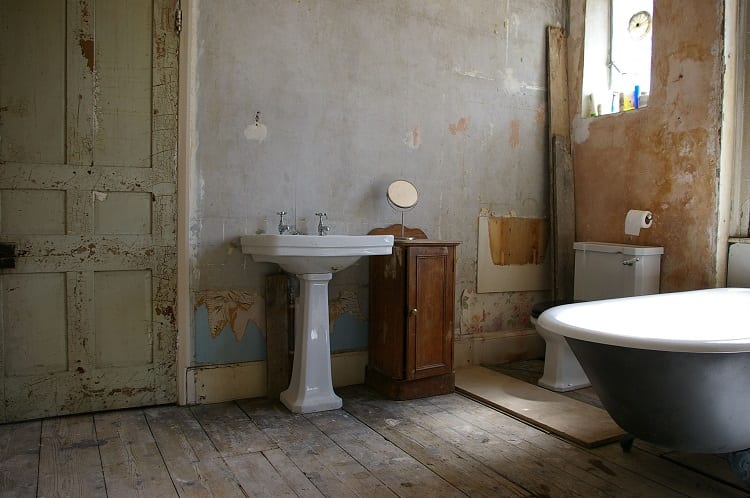
Planning to renovate your bathroom all the way up from the floor to the ceiling?
You sure will have a lot of old stuff at your hands to deal with.
However, ‘out with the old and in with the new’ doesn’t necessarily mean that the old should end up in a junkyard.
There are various ways in which you can repurpose the stuff from your bathroom that you no longer need.
For instance, you can turn your old bathtub into a garden pond.
Add some real or toy fishes and water lilies to enhance the appeal. Or you can even fill it with soil to grow plants and flowers indoors.
Or how about turning it into about a stylish lounger for your living room?
Similarly, you can refurbish the vanity as well. Repaint it to go with your new bathroom layout.
If it’s been damaged with use, see if you can salvage the drawers or some wooden planks.
Use them to make an open shelf, a tabletop, or whatever else you want.
When it comes to repurposing old bathroom furnishings, the sky’s the limit, and creativity’s your best friend.
If you must throw the stuff out, consider selling it online instead.
There are many DIY enthusiasts who will be more than happy to get their hands on some more stuff for upcycling.
How to Remove Old Tiles In Your Bathroom?
So, you were sick of the drab décor in your old bathroom and quite literally want to leave no stone unturned when it comes to renovating it.
You have probably already bought some stylish new tiles, or at least have some trendy designs in mind.
It’s time to get the old tiles out.
Make no mistake though. Removing bathroom tiles requires skill and effort.
It is likely to take a lot of time too, especially if you want to reuse the tiles somewhere else.
Follow these tips to prep your bathroom floor and walls for a makeover:
Safety First
No matter how carefully you might try to pry them off, shards of ceramic and porcelain can come flying at you when you are removing bathroom tiles.
Make sure that you are wearing safety glasses in addition to protective gloves and overalls.
Ideally, you should ask a friend or family member to help you out during this step.
It would help to have someone who can hold the larger tiles so that they don’t fall and break as you remove them from the wall.
Gather the Tools
The two main tools that you need for removing bathroom tiles are a hammer and a thin chisel.
You can use a large flat-headed screwdriver if you don’t have a chisel at hand, although it will make the task a tad harder.
Protect the Fixtures
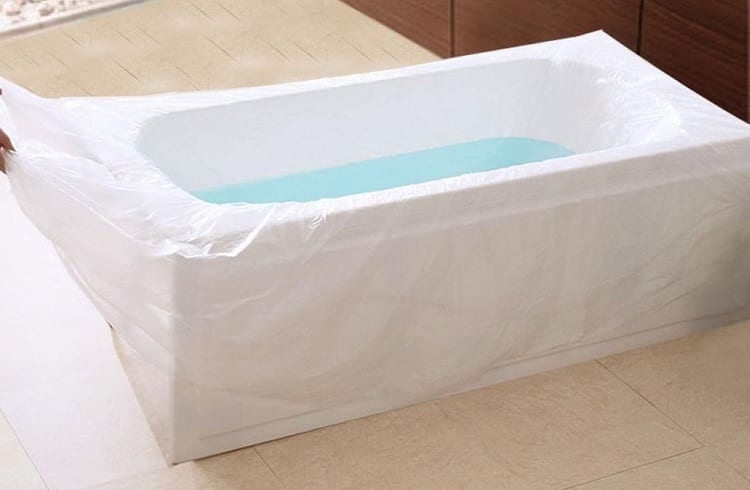
Once you have armored up, you need to do the same for your bathroom fittings.
Remove all the extra items from the room, including bath products, towels, etc. then, cover the usable floor with a drop cloth or a large sheet of thick plastic.
To protect the fixtures, place cardboard over each item and then drape plastic over it for extra protection.
Make sure that the tub/ shower, vanity, mirrors, and toilet seat are properly covered before you start.
Close the Drains
Use a painter’s tape to tightly cover the drains; otherwise, cement chips can cause a blockage.
From a safety point of view, it’s a good idea to thoroughly clean the bathroom and wash the floor before you start removing the tiles.
Removing the Tiles
Finally, on to the main part.
Keep in mind that removing the first tile is usually the hardest.
They are all set firmly in the grout, and it’s difficult to find a suitable starting point.
If you can locate a loose tile and get it off successfully, that’s great!
However, in most cases, you need to sacrifice a tile or two to get started.
Pick any tile near the edge and hit it in the center with the hammer. It will shatter into small pieces.
Carefully remove the pieces. You would now have access to the surrounding tiles. Continue removing them one by one.
The Substrate
If the tiles come off easily, leaving the substrate beneath intact, thank your lucky stars!
You just saved yourself some extra money. However, this happens only rarely.
Despite your best efforts, the substrate is likely to sustain some damages.
In that case, you can remove it completely by using an electric saw.
Start cutting into the substrate from the side, keeping the blade at a low angle.
Run the blade along the length of the tile, and you should be able to lift up the cement board easily.
Once all the tiles are removed, clean the debris thoroughly. You can now install the new tiles.
What About Piping?
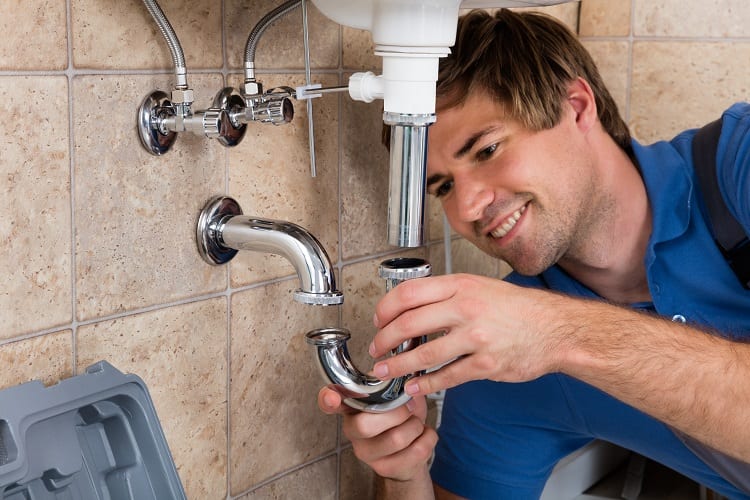
The million-dollar question when it comes to bathroom renovation is: should I replace the plumbing?
The answer is quite simple and straightforward.
If your house was built more than two or three decades ago, you should consider replacing the plumbing.
Even if there are no apparent problems, it goes without saying that your plumbing is outdated.
For houses built during the ‘70s or earlier, not replacing the plumbing is out of the question.
This is because you would probably have cast-iron pipes.
Cast iron was the material of choice for water lines and sewage pipes installed during this time.
Although they were designed for longevity, cast iron pipes are not hydraulically efficient.
They are vulnerable to corrosion and result in hidden leaks.
Therefore, to prevent seepage and maintain the structural integrity of your bathroom, it would be best to replace cast iron plumbing.
The interesting thing to note is that many homeowners feel obliged to ‘fix’ the plumbing while they are renovating the bathroom.
You shouldn’t touch the piping unless it is absolutely necessary.
The following section will help you decide whether or not you need to touch upon plumbing during bathroom remodeling.
How to know if you should remove old pipes/drainage?
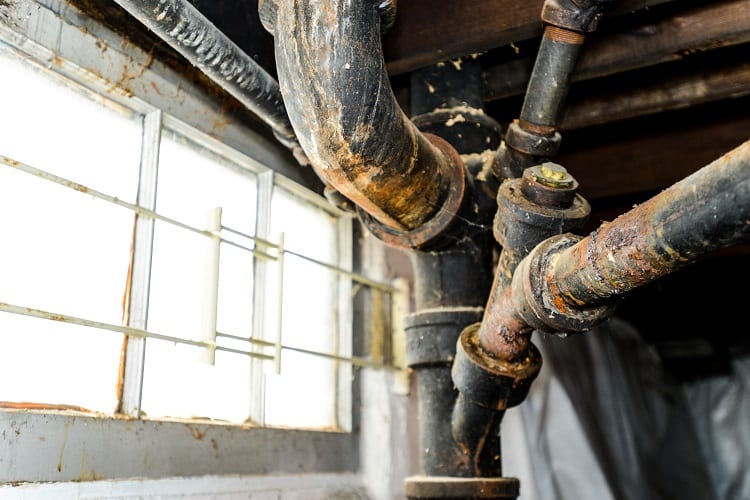
Look for these common signs that warrant plumbing repair or replacement:
- There’s rusty water coming out of your taps
- You encounter frequent leaks, or the leak persists even after you have tried to fix it
- The water from the tub or sink drains very slowly despite proper cleaning
- Your drain blocks every now and then
- You smell sewer gas in the bathroom
- Mold or mildew growth in your bathroom
- Indentations or sagging in the bathroom floor
- Cracks or water stains on the walls
6 Steps for Bathroom Remodel
Getting Started
First and foremost, you need to establish what your new bathroom would look like. Different designs require different skills.
Make sure you have the right skill set and the complete tools required to bring your vision to life.
Some of the main design elements that you need to consider before getting started include:
- Color scheme – Do you prefer the traditional blue and white hues or want to go for more distinct colors like red instead? Your preferred color scheme determines whether you need to repaint the walls and/ or change the tiles
- New fixtures – Do you need to replace all the fixtures or just want to upgrade the shower or the vanity? The more fixtures on your list, the greater will be your total cost
- Storage space – Make sure your new design has plenty of storage space for the toiletries. For instance, if you are replacing the vanity with a standalone sink to make room for a tub, install shelves to keep the towels and other bath products post-remodel
- Utilities – If you are only doing surface-level upgrades know where the electrical wiring and water pipes are located. Obtain accurate measurements otherwise you might end up incurring extensive and expensive repairs
Tool Up
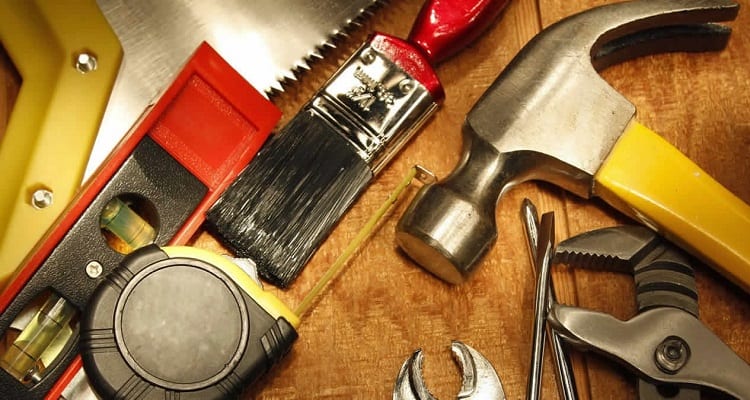
The list of basic tools you will need for a DIY bathroom remodel include, but is not limited to, the following:
- Safety mask, gloves, goggles
- Hammer
- Tape measure
- Pry bar
- Chisel
- Bucket
- Adjustable wrench
- Screwdriver set
- Utility knife
- Power drill (preferably cordless)
- Silicone sealant
- Caulking gun
- Extension cord
Piping/ Drainage Replacement/ Upgrade
As we mentioned earlier, not every bathroom remodel necessitates piping or drainage replacement.
In most homes, repairs remain the viable option for years. It is perfectly normal to occasionally encounter clogged drains or a leaking pipe.
Typically, these problems can be easily solved using over-the-counter drain cleaners and basic know-how of plumbing repairs.
However, if this occurs repeatedly, getting in touch with a professional plumber might be a smart move.
They can inspect your pipes from the inside and out and help you decide if a piping replacement is required.
Know the Lifespan of Your Pipes
Copper pipes have an average lifespan of 80 years, whereas galvanized steel can last for up to 100 years or more.
However, their durability is heavily affected by factors like insulation, the types of drain cleaners you use, and how frequently you use them.
Chemically strong cleaners, especially those containing concentrated sulfuric acid, can cause major damages to the piping when used repeatedly.
It will surely increase your total expenditure by a significant amount.
But it would still be a more cost-effective solution in the long run as you will be able to save money on wasted repairs.
Discoloration
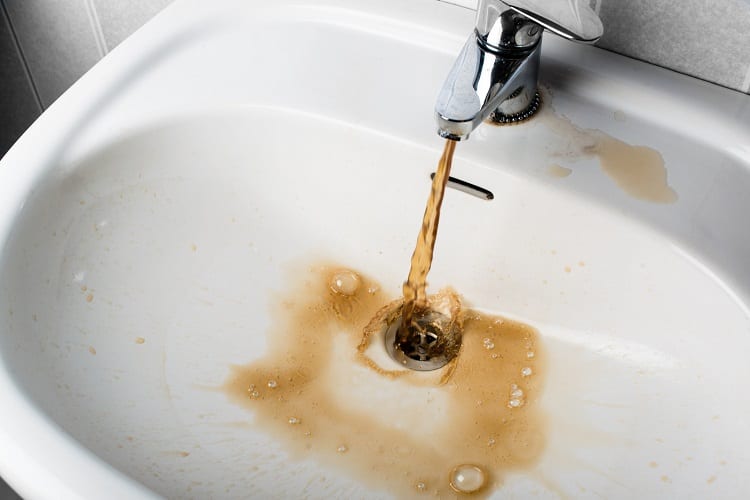
Discoloration generally means that there’s brown or yellow colored water coming out from the taps.
At times, you might also notice small black particles in otherwise clear water.
This indicates rust in your piping and calls for a piping upgrade.
However, discoloration is usually harmless if you live in the suburbs or use water from a well.
This is because the color is generally due to mud and sand mixing with the water supply.
Make It More Affordable
Re-piping an average-sized bathroom can cost anywhere between $1,500 and $15,000.
It can go even higher depending on the type of pipes being installed and other factors like the structure of the house.
One way to save on plumbing costs is to do the work yourself. But be careful not to bite more than you can chew.
If you feel you cannot handle it on your own, hire a professional.
Do an online search to get competitive bids from your local plumbers.
Or repipe only the exposed plumbing if you think that the hidden piping is still in good condition.
HVAC (Replacing Exhaust Fans, Heating, Water Heater, etc.)
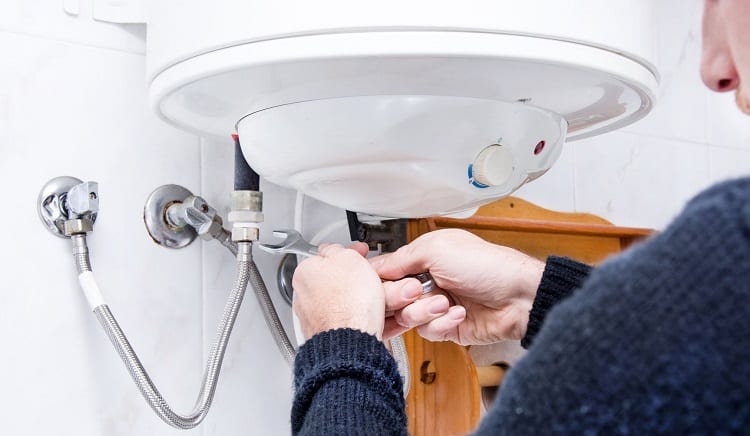
Upgrading HVAC can be one of the most challenging steps of a bathroom renovation.
The reason?
There are too many technicalities involved.
Plus, there are several types of bathroom fans and water heaters to choose from. This can end up confusing you even more.
The cost of the exhaust fan alone can range from as little as $15 to $300 or more.
As for the water heater, you can get a mini portable heater for around $300, whereas the high-end options can easily total $11,000 on average.
Bathroom exhaust fans help prevent moisture build-up by clearing out steam.
Therefore, don’t hesitate to invest in an efficient exhaust fan. Inexpensive fans are usually unable to keep the humidity level low.
This promotes fungal growth can create water stains as well.
Check the Permit
In many regions, homeowners cannot meddle with the HVAC units at freewill.
Check your local state and building codes to see whether you are allowed to do electrical work in your home by yourself.
You might need a special permit, or you might have to call in a licensed contractor instead.
Upgrading the Bathroom Fan
Pick the right fan for your bathroom using their CFM rating.
CFM, which stands for cubic feet per minute, it’s a measure of airflow.
The size of your bathroom determines the number of CFMs you need.
Small bathrooms need about 50 CFM. If you have a bathroom that is bigger than 100 square feet, set a margin of 50 CFM for each fixture (toilet, shower, tub, jet tub).
Also, make sure that the new fan is compatible with the existing ductwork and electrical outlet.
Flooring
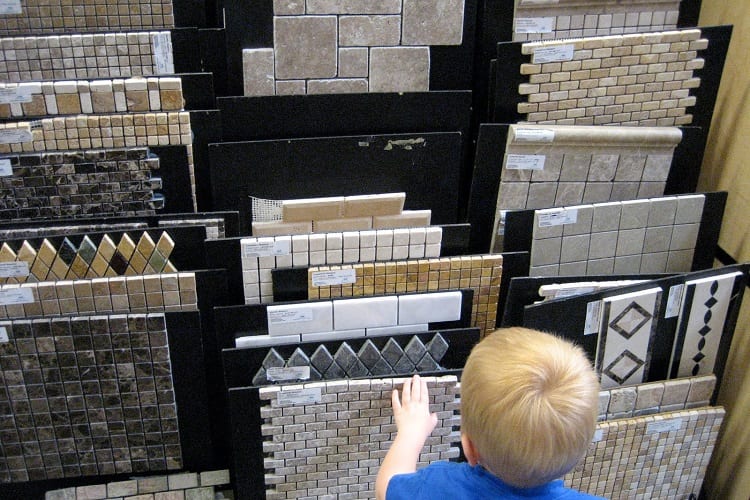
Remember, when choosing the color of the floor, it’s best to stick with neutral tones.
Brightly colored floors or tiles with fancy designs draw your eye down.
This can compromise the overall aesthetic qualities of the bathroom.
Subtle floor design keeps contrast at countertop level and makes the room look more spacious.
If elderly members will be using the bathroom, pay close attention to the performance of the floor.
Reduce slippage by installing textured tiles or placing rubber mats near the sink and shower.
What are the best options for bathroom flooring?
Ceramic tiles are the classic choice for bathroom floors. If you need to give it a more modern spin, porcelain tiles that mimic natural stone offer an impressive style.
Weigh out the pros and cons of different types of bathroom flooring to tell which one is right for you:
Ceramic/ Porcelain Tiles
Pros
- Comes in a variety of designs
- Offer good resale value
- Work well in bathrooms with radiant heating
- Easy to clean
Cons
- Feel cold under feet
- Slippery, hence not suitable for showers
- White tiles offer a sterile look
Vinyl Flooring
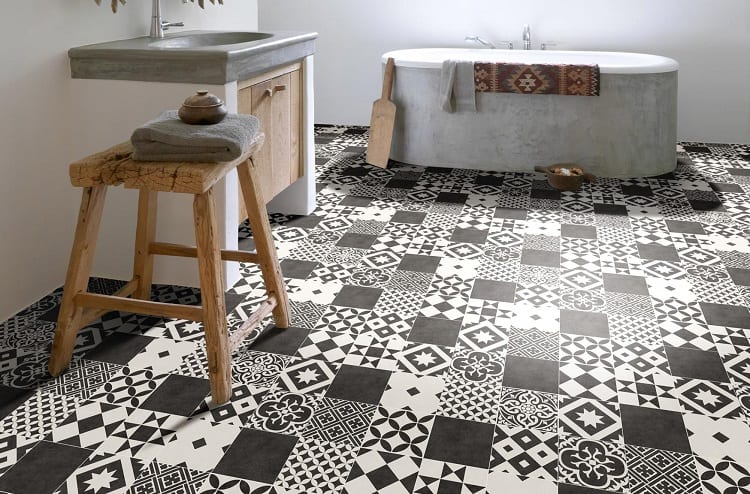
Pros
- Available in various forms (sheet, plank, and tile)
- Easy to install
- Inexpensive flooring solution
- Lots of design options
- Vinyl planks are waterproof
- Can be replaced whenever required
Cons
- You need to level the subfloor first
- Do not offer good resale value
Natural Stone
Pros
- Trendy looking
- Very durable
- Increase property value
Cons
- High-priced
- Require professional floor installers
Engineered Wood
Pros
- Ideal for wood-themed bathroom
- Has a long lifespan
- Gives a really luxurious look
Cons
- Quite expensive
- Difficult to install yourself
Walls
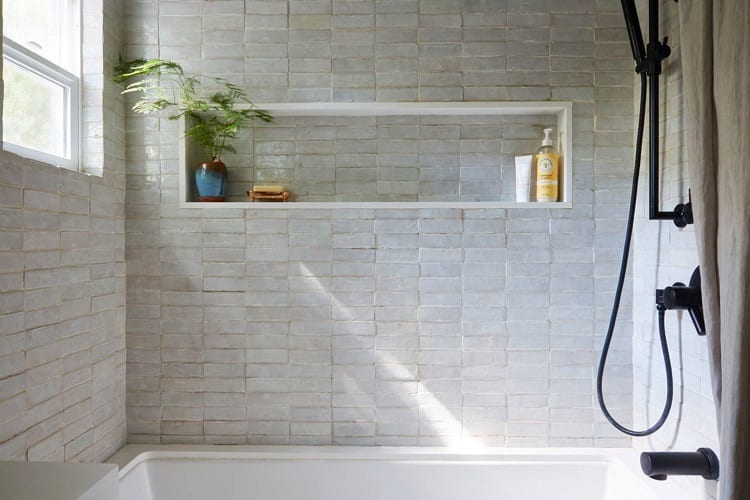
On to the battle between tiles and paint.
Which is the right option? Should you leave your bathroom walls untouched? Switch from tiles to paint or vice versa? Or should you simply repaint/ retile them to go with the new interior?
There are a number of things to consider when it comes to upgrading walls in bathroom remodeling.
Maintenance, style, and durability are the top three factors to take into account.
Repainting
if you are renovating your bathroom on a budget or don’t have a lot of time to spare on walls, repainting them will be the better option.
However, remember that plains walls are highly susceptible to moisture retention and subsequent damage.
The paint usually starts chipping and becomes contaminated with pathogens like mold and mildew in a couple of years or even months.
Therefore, if you are not tiling your bathroom walls, give due attention to the ventilation system.
Install a high-power exhaust fan so that the paint doesn’t easily erode or become discolored.
Wall Tiles
It doesn’t take a genius to figure that as compared to painting the walls, tiles will stand the test of time in a bathroom.
Plus, with tiles, you have plenty of options to make a style statement through eccentric designs and contrasting colors.
These are easy to clean and maintain. For this reason, tiles are more hygienic too.
Plus, they are odor resistant, stain proof, moisture resistant, and more environment-friendly than painted walls.
Anti-Humidity Paintings
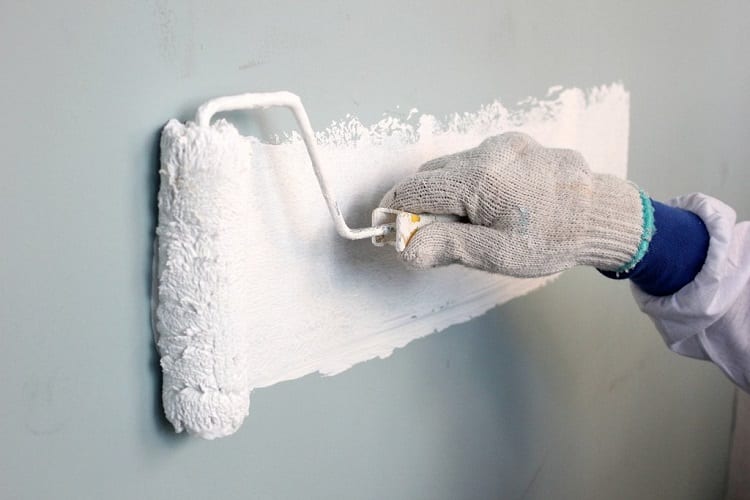
The bathroom is, no doubt, the most controversial of all rooms when it comes to displaying art in your home.
But if you have a taste for art, what’s there to stop you?
Whether you want to give your bathroom a chic look or want to enjoy your favorite works in the most intimate space in your house, anti-humidity paintings allow you to fulfill your desire.
These are made from moisture-resistant paint and can withstand the high humidity in places like the bathroom.
Alternatively, you can buy anti-moisture paint from most leading home improvement stores.
You can paint the entire bathroom walls with it, and they won’t require another paint job for a couple of years.
How High?
When tiling the bathroom walls, the standard height is 54 inches.
You may want to go higher, especially near the shower area to prevent water splashes from damaging the untiled part.
Tiling all the way up to the ceiling is a highly effective way to protect the walls from moisture.
But it requires a lot of time and effort, and of course, money.
You can go ceiling-high just on one side to make an accent wall too.
Finish your tiled walls with decorative trim for a truly stunning end look.
Tub vs. Shower
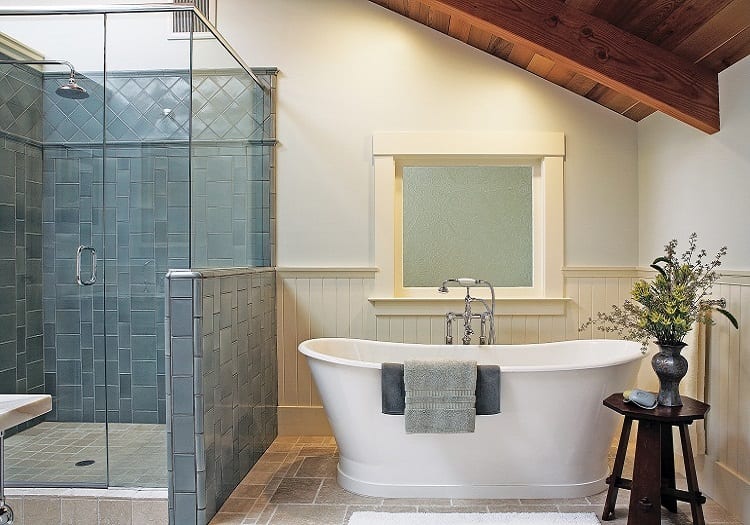
If you are unsure about installing a tub or a shower in your bathroom, here’s a quick rundown of the pros and cons of each:
Bathtub Advantages
- Must-have for a relaxing bath experience
- An ideal option for bathing kids
- Available in a wide variety of styles and sizes to suit different bathrooms
- Freestanding units are easier to install and can be placed virtually anywhere
- Can include special features such as air jets, whirlpool, etc
Bathtub Disadvantages
- Not user-friendly for old aged or disabled people
- Takes up a lot of space
- Can increase your water bill
- Requires water heater with adequate capacity
Shower Advantages
- Ease to install and use
- Quick and convenient
- Economical bath option
- Frees up space for other bathroom utilities
- Walk-in showers are ideal for people with mobility issues
- Can be fitted with grab bars, bench, and non-slip tiles for added comfort
- High-end features available for e.g., rain shower, jet, and steam option
- Environment-friendly
Shower Disadvantages
- Not a practical option if you have children
- Require proper cleaning especially if you install a shower door alongside
When replacing the tub or shower during bathroom remodeling, think about the prospective buyers for your house down the lane.
Generally, it’s good to have at least one bathtub in the house.
Cost of Walk-In Showers
Walk-in showers are usually the go-to bath option for handicapped users.
They ensure safety and provide more independence to people who might otherwise need assistance in bathing.
The total cost of installing a walk-in shower will vary depending on the material (fiberglass, acrylic, etc.) and the related accessories.
Full shower units come as a kit that fits perfectly in the desired space. They typically cost around $2,300.
On the other hand, shower pans are a less expensive option for accessible bathing.
They cost around $400 to $700 on average but require some preliminary work for installation.
Bathroom Cabinets
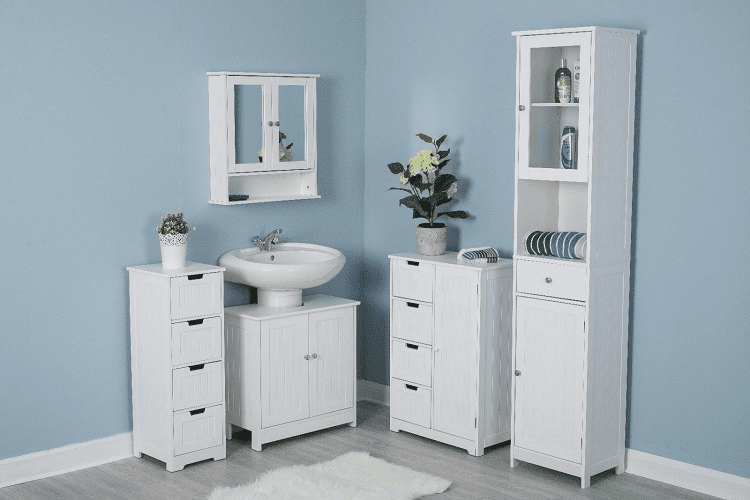
Bathroom cabinets need to be both functional and stylish.
The most common types of bathroom cabinets include a combination of drawers and shutters.
They are installed directly below the countertop to provide easy access to toiletries.
If you are going for a pedestal sink, then the cabinets can be installed on walls instead.
No matter how short of space you are, never skip on a bathroom cabinet.
Even a small cabinet with a depth of 6 to 8 inches is sufficient enough to hold bathroom linen and other essentials.
What Kind of Materials Should You Seek for Your Cabinet?
For hassle-free maintenance and longevity, it’s essential to choose the right material for your cabinets.
Bathrooms are a moisture-laden area, so the base material, as well as surface finish, should be able to tolerate the high humidity.
The most popular materials for bathroom cabinets include:
- Waterproof plywood – a stable material mainly used for creating the basic framework
- Laminate – Stain and water-resistant. Available in matte and glossy styles. Provides a fine finish to the cabinets
Cabinet+ Sink Vs. Sink Alone
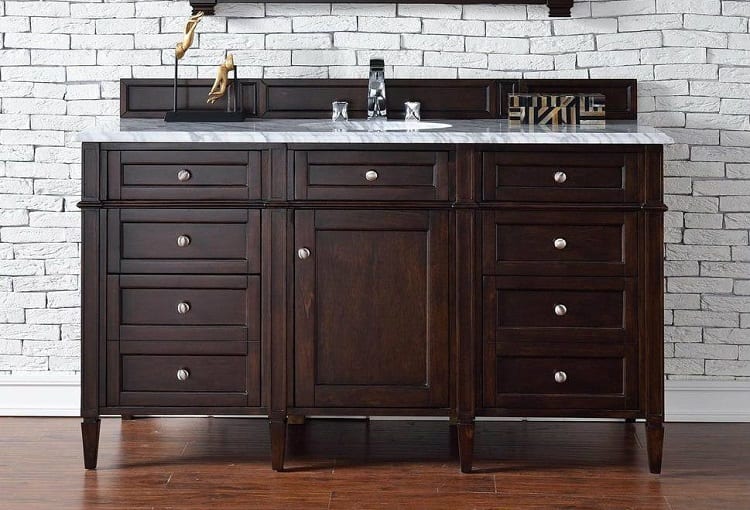
Standalone sinks, commonly known as pedestal sinks, are making a huge comeback in modern bathrooms.
Although they have a somewhat vintage style, the color choice, overall structure, and strategic placement lend them a contemporary touch.
They are the most practical option for small-sized bathrooms but look equally impressive in half-baths or powder rooms as well.
The best part is that they are extremely easy to install. So, for DIY bathroom remodeling, a standalone sink is usually the preferred choice.
Installing cabinet and sink as a joint unit might make more sense if you have considerable space and want to utilize it in the best possible manner.
Bathroom vanities offer numerous options in terms of color, size, material, and design.
You won’t have any trouble finding one that fits within your budget.
However, they can be hard to maintain. Plus, their installation can add to your total cost for bathroom renovation.
Toilet Replacement
Check your current toilet against the following factors to see if your bathroom remodeling warrants toilet replacement or not.
- Leaks – Leaks within the toilet bowl, tank bolts or water damage on the floor around the toilet must be addressed promptly. If there’s no improvement, consider replacing the toilet
- Poor water efficiency – Old toilets can use up to 7 gallons of water or more with each flush. Modern toilets use an average of 1.6 gallons of water per flush. If you don’t know when your toilet was manufactured, lift the lid and see the date stamp
- Appearance – Will your existing toilet merge seamlessly with the new bathroom interior? If not, you might want to find a unit that better compliments the new design
- Broken components – If your toilet needs repairs, weigh the costs against the price of buying and installing a new unit. Go with the more feasible option
Unless you have a complete grip on the task, it’s best to leave toilet replacement to a professional.
Since it can be really heavy, porcelain toilets can get chipped or cracked during handling.
An expert can complete the job safely and successfully.
Other Bathroom Vanities
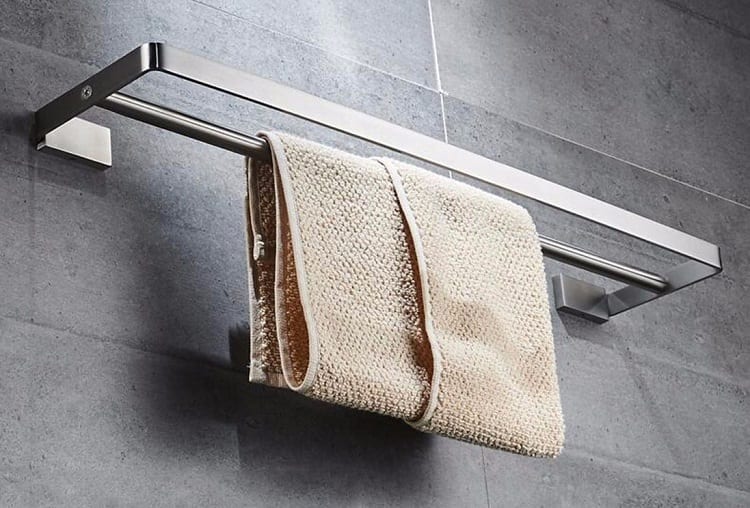
Bathroom shelves, cabinets, and other vanities come in both framed and frameless designs.
The traditional style is to leave all the hardware and sanitary fitting visible.
This allows you to opt for open shelves and standalone (usually wall-mounted) storage units.
If you are all about a modern makeover, you will want to hide the fixes, and for that, framed bathroom vanities are the ultimate solution.
Besides the towel holder and shelves for storing the toiletries, don’t forget a medicine cabinet.
Go for recessed cabinetry as it offers a more open look in addition to simplifying the cleaning process.
Conclusion
Renovating a bathroom is surely fun and exciting, but without proper planning, it can quickly turn into one of the biggest disasters of your life.
Even if there’s a slight hiccup in the process, the whole project can go downhill from there.
Whether you are looking at a complete overhaul or just some minor upgrades to give your bathroom a quick makeover, this guide is sure to come in handy.
We hope that after reading this detailed guide to bathroom remodeling, you are now better prepared to take on the task with confidence.
If you feel like you still need some more tips suggestions on how to go about renovating a bathroom, check out some of our other articles as well.
We wish you the best. Happy remodeling!
